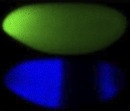Stability of localized wave fronts in bistable systems
Steffen Rulands, Ben Klünder and Erwin Frey
Localized wave fronts are a fundamental feature of biological systems from cell biology to ecology. The stability of these wave fronts is often paramount to the fate of these systems. As an example, in the embryogenesis of Drosophila melanogaster the stable localization of the Hunchback protein is pivotal for the embryo's development.
Here, we study a broad class of bistable models subject to self-activation, degradation and spatially inhomogeneous activating agents. We determine the conditions under which wave-front localization is possible and analyze the stability thereof with respect to extrinsic perturbations and internal noise. It is found that stability is enhanced upon regulating a positional signal and, surprisingly, also for a low degree of binding cooperativity. We further show a contrasting impact of self-activation to the stability of these two sources of destabilization. The conflict between intrinsic and extrinsic stability affects, for example, the design of gene circuits in developmental systems. Our results suggest different design principles depending on the particle number.
Picture taken from
F. J. P. Lopes, F. M. C. Vieira, D. M. Holloway, P. M. Bisch, and A. V Spirov, PloS Comput. Biol. 4, e1000184 (2008).


